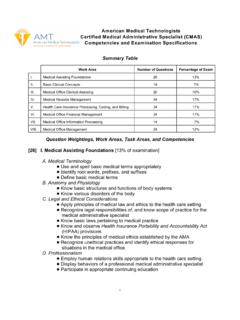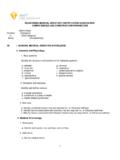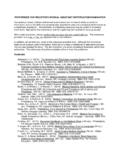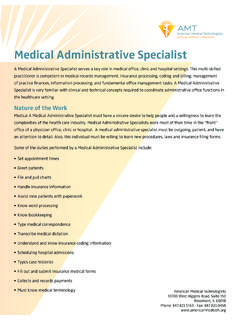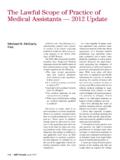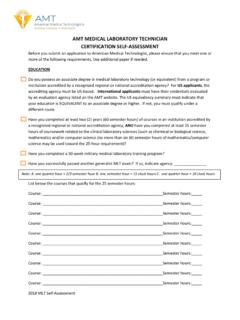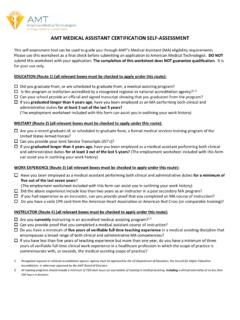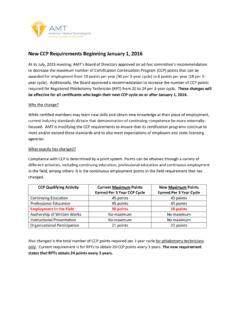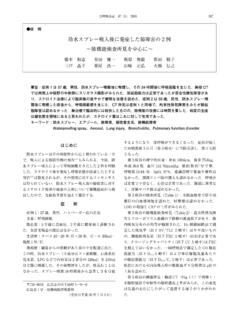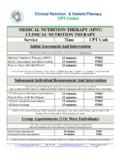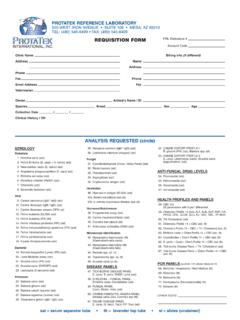Transcription of Medical Technologist (MT) and Medical Laboratory ...
1 Medical Technologist (MT) and Medical Laboratory technician (MLT). Certification Examination Content outline General Laboratory (MT=12%, MLT=13%)_____. Laboratory quality Demonstrate knowledge of quality control for all Laboratory procedures and determine the acceptance or rejection of an analysis based on quality control rules Demonstrate knowledge of proficiency testing Demonstrate knowledge of quality control terminology to include: linearity coefficient of variation confidence limit accuracy skewness Levey-Jennings charts precision mean value normal distribution reliability standard deviation standard deviation index (SDI). Delta OD shift, trend Employ quality improvement (TQM, CQI, PIC). Laboratory laws and regulations Know laws and regulations governing the Laboratory (OSHA, CLIA, HIPAA).
2 Laboratory safety Employ Laboratory safety Employ chemical hazard safety and Safety Data Sheets (SDS). Employ proper infection control Employ Universal / Standard Precautions Employ equipment safety (including sharps receptacle for needle disposal). Laboratory instrumentation, maintenance, and principles of operation Employ manual Laboratory instrumentation (including the use of glassware and pipettes, and the cleaning and maintenance of instruments). Calibrate instruments knowing the difference between technologies requiring calibration versus those requiring only quality control checks Setup, balance, and operate centrifuge knowing durations, RPM, RCF. Employ automated Laboratory instrumentation Laboratory mathematics Apply Laboratory mathematics; understand and calculate essential indices including mean, standard deviation, and coefficient of variation Demonstrate understanding of normal solutions, molar solutions, and percentage solutions (w/w, w/v, v/v), and calculate equivalent weights and dilutions most frequently used in the clinical Laboratory Demonstrate knowledge of abbreviations/designations used for weights and measures Microscopy Demonstrate knowledge of microscopy including types of microscopes and parts of binocular microscope Use and clean binocular microscope and calibrate ocular micrometer 1.
3 Phlebotomy and specimen collection (including specimen handling and integrity). Collect, handle, and process all specimens for analysis (including infant collection). Understand the differences between serum, plasma, and whole blood Employ procedures to prevent hemolysis Employ safety precautions when collecting blood samples Collect blood in collecting tubes for analysis (clotted blood and anticoagulated blood). Employ proper anticoagulants for each analysis and know effects of improper anticoagulant use Know length of time in which samples clot Employ proper order of draw when collecting blood in multiple types of vacuum tubes Know procedure for blood culture collection Perform infant blood collection through heel puncture Know the proper labeling of blood tubes including sentinel event with blood bank armbands Handle and preserve body fluids for chemical analysis Preserve urine specimens Perform glucose tolerance test Process irretrievable specimens (CSF, tissue, etc.)
4 Determine the suitability of specimens for analysis Determine preanalytical, analytical, and/or postanalytical causes of erroneous results Patient Identification Assure continual accuracy of patient identification (including STAT, call reports for inpatient and outpatient, etc.). Match name, MR, DOB, registration number, and other identifiers with tests and orders to confirm positive patient identification Waived Testing Demonstrate knowledge of waived testing in the clinical Laboratory Clinical Chemistry (MT=19%, MLT=18%)_____. General knowledge Define clinical chemistry terminology: spectrophotometry densitometry chromatography refractometry electrophoresis chemiluminescence turbidimetry nephelometry osmometry mass spectrometry enzyme linked immunoassay (ELISA). fluorescence polarization immunoassay (FPIA).
5 Define terminology related to principles of clinical Laboratory instrumentation: radiant energy visual spectrum/wavelength Beer-Lambert Law end point reactions diffraction grating kinetic/rate reactions random access 2. Instrumentation Demonstrate an understanding of the visible spectrum and wavelength Demonstrate an understanding of the Beer-Lambert Law Demonstrate the ability to operate, and describe the principles of operation of the osmometer and nephelometer Demonstrate knowledge of the principles of immunoassay Demonstrate knowledge of the principles of electrophoresis Describe chemistry analyzer maintenance Renal function tests Describe physiology and know anatomy of the kidneys Perform common renal function tests (non-protein nitrogens), clearance tests, and estimated glomerular filtration rate Demonstrate knowledge of renal function tests and correlate results with pathological conditions affecting kidney function.
6 Know reference limits Hepatic function tests Demonstrate understanding of the anatomy and physiology of the liver Describe types of bilirubin and types of jaundice, and understand the formation of bilirubin and urobilinogen Understand and perform common hepatic function tests Describe and differentiate tests that are elevated in liver disease, obstructive jaundice, and hemolytic jaundice Carbohydrate metabolism Define carbohydrate metabolism terminology: carbohydrate ketones lipogenesis glycogen monosaccharide insulin renal threshold glycogenolysis disaccharide glycolysis diabetes mellitus polysaccharide A1C hemoglobin glycogenesis Describe insulin and carbohydrate metabolism, classification of carbohydrates, carbohydrate digestion, A1C hemoglobin, and types of diabetes Perform and interpret tests for glucose analysis to include all tests for carbohydrates and reducing substances, and those performed on blood, urine, and spinal fluid Perform oral glucose tolerance test.
7 Recognize and differentiate normal glucose tolerance, diabetic glucose tolerance, and hypoglycemic (flat) curves Describe the principles of, and perform glycohemoglobin A1C procedure Protein analysis Describe the structure and function of plasma proteins; synthesis, distribution, catabolism, and excretion of proteins; protein classification Perform tests measuring total protein, albumin, globulin, and immunoglobulins;. know reference limits Describe principles of protein electrophoresis; recognize and interpret normal and disease patterns in serum protein electrophoresis Demonstrate knowledge of clinical protein analysis and correlate test results with disease states 3. Enzymology Demonstrate understanding of enzymology concepts: Clinically-significant enzymes (CP, ALP, ALT, AST, CK, GGT, LD, lipase, amylase).
8 Isoenzymes (CK, ALP, LD). Measurement of enzyme activity Pancreatic enzymes Enzymes associated with the liver and liver disease Cardiac markers and their uses Differentiate enzymes of the pancreas and tests used to determine enzyme activity Differentiate liver diseases based on elevated enzyme indications Demonstrate knowledge of acid phosphatase and alkaline phosphatase and correlate with disease states Describe cardiac enzymes and interpret test results; describe order in which cardiac enzymes rise and return to normal Demonstrate knowledge of cardiac marker tests: troponin T and I, myoglobin, B. natriuretic peptide (BNP), and C-reactive protein (CRP). Endocrinology Demonstrate understanding of endocrinology concepts: Glands and hormones of the endocrine system Function of hormones Feedback mechanisms Common tests and reference ranges Conditions resulting from hypo- and hypersecretion of hormones Demonstrate knowledge of thyroid function tests (thyroxin, TBG, free T3, free T4, TSH).
9 Demonstrate knowledge of 24-hour urine endocrinology tests (T3, 5-HIAA). Demonstrate knowledge of tests for reproductive hormones (FSH, LH, estriol, estradiol, estrogen, testosterone, 17-ketosteroids). Demonstrate knowledge of tests for pregnancy hormones (HPL, HCG, prolactin). Lipids Demonstrate understanding of concepts related to lipids; describe the function of protein in the lipoprotein complex, and understand the metabolism of cholesterol and triglycerides Demonstrate knowledge of lipid analyses and correlate hyperlipidemia with coronary artery disease; know desirable limits for total cholesterol, LDL, and HDL. Water and electrolytes Demonstrate knowledge of electrolytes in body fluids and understand common causes of electrolyte imbalances Measure electrolytes and interpret abnormal test results to determine type of imbalance Describe methodology for measurement and calculate osmolality 4.
10 Acid-base balance Demonstrate understanding of concepts related to acid-base balance; hydrogen ion concentration (pH); regulation of acid-base balance by kidneys and lungs Demonstrate understanding of the relationships between pH, bicarbonate, and carbonic acid (Henderson-Hasslebach equation). Describe common acid-base imbalances Demonstrate knowledge of tests for acid-base balance Cerebrospinal fluid Demonstrate understanding of cerebrospinal fluid (CSF) formation, characteristics, volume, function, and collection Perform CSF analysis Other Chemistry Procedures Demonstrate understanding of tumor markers Demonstrate knowledge of principles of electrophoresis; protein electrophoresis, immunoelectrophoresis, isoenzyme electrophoresis (LDH, CK, alkaline phosphatase), hemoglobin electrophoresis Demonstrate knowledge of minerals of the body and mineral metabolism Understand the principles of therapeutic drug monitoring and toxicological tests peak and trough antiepileptic drugs and metabolites mechanism of action cardioactive drugs and metabolites steady state kinetics antidepressive drugs pharmacodynamics immunosuppressive drugs pharmacokinetics antibiotics beta blockers and calcium channel blockers screening versus confirmatory tests Perform tests for drugs of abuse Analyze body fluids for glucose, total protein, and LDH.
